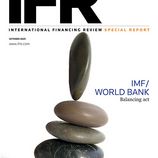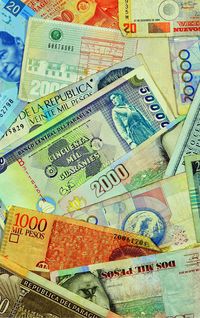While fears were expressed for what might be in store for the emerging markets in the face of the year's various ordeals, the outcome has been far more positive than many supposed
Despite 2020’s unsupportive backdrop – the global pandemic, the oil shock, record sovereign defaults, repeated downgrades and potential crowding-out from increased developed market supply – bond sales for emerging markets credits have boomed this year. Only the weakest EM names have struggled for international market access. But with sentiment souring fast in the short window before the US election, key tests of risk appetite lie ahead.
Shrugging off March’s shock when lockdown-inspired risk aversion pulled as much as US$34bn out of EM debt, according to the Institute of International Finance, EM new issue activity is up year-on-year in 2020. All EM regions have seen increased international bond activity compared to the same period of 2019, data from SDC show.
Indeed, this year’s EM international new issue volume is already neck and neck with 2018’s full-year total of US$585bn. At this rate, it is on course for one of the highest full-year volumes of all time despite headwinds such as the pandemic, oil and what Fitch notes as a record number of sovereign defaults, including those of Argentina, Ecuador, Lebanon and Suriname.
February’s oil shock, which drove futures prices into unprecedented negative territory, weighed significantly, as many EM economies are highly dependent on the commodity. Downgrades quickly followed, with S&P lowering its assessment of five oil producers - Angola, Cameroon, Nigeria, Oman and Kuwait.
Inevitably, investment-grade EM sovereigns have fared best in this environment. To help fund their responses both to Covid-19 and the economic downturn resulting from the pandemic, they were able to tap into buffers such as sovereign wealth funds, fiscal savings funds and their local domestic investor bases – options generally unavailable to weaker credits.
“The investment-grade sovereigns entered this period of economic turbulence with much better buffers to underpin their issuance,” said Jeff Grills, head of emerging markets debt at Aegon Asset Management.
This strong backing has enabled sovereigns to source as much as US$185bn in international bond issues already in 2020, according to Allianz Global Investors.
Far from crowding EM out, central banks’ support programmes have played a role in this strong performance. As their bond buying ground developed yields and spreads even lower, investors were driven into higher-returning EM credit, fuelling year-on-year growth in EM new issues.
“It really hasn’t been a problem for them to come back to market after the initial stage of the pandemic,” said Nicolas Jaquier, EM strategist at Allianz. “The fact that a large part of developed market supply was bought through QE was helpful, and with the continued hunt for yield, EM comes into play. They have been quite successful at taking advantage of a benign market.“
“No one should be thinking that EM is suffering or doubt the strength of demand,” said Andrew Macfarlane, EM sovereign credit analyst at Bank of America. Among more recent deals, he cited the US$24bn order book attracted by Abu Dhabi’s US$5bn deal in August, as well as the partial “positive surprise” of Bahrain’s reception in September, when it issued US$2bn across a dual sukuk and conventional offering – though the Single B sovereign did have to drop a planned 30-year tranche.
“That clearly reflects sentiment in an environment where central bank buying is forcing people into EM,” said Macfarlane, who emphasised that demand has focused on higher rated EM countries. “They’ve got to find yield somewhere.”
EM corporates too - particularly from Asia, which accounts for two-thirds of 2020 new issue volume despite India’s ratings and Covid challenges - have had “a very strong year”, according to Theo Holland, head of emerging market corporate debt at Fisch Asset Management.
“It’s been a year where the intrinsic resilience of EM credit has played out, though the wider risk backdrop can influence it along the way,” he said, citing a number of investment-grade and high-yield corporate deals pulled in late September. “But we remain believers in the sector’s ability to navigate this event.”
Even so, Aegon’s Grills sounds a note of caution over potential credit deterioration. “Investment-grade names can issue much more easily, but it could cause a decline in credit quality if taken too far. It’s one to watch going forward.”
EURO ANGLE
This year’s strong EM demand has come from US dollar and euro investors alike, market sources report. Although the absence of euro-denominated instruments from the key EM bond indices tilts demand towards the US currency, European investors have nonetheless stepped up EM activity lately as hedging US dollar exposure has cheapened – and despite some euro EM bond funds having seen outflows recently.
“A big role for investment-grade sovereigns after the March liquidity crunch has been the collapse in hedging costs for euro investors. That has generated more appetite,” said Jaquier at Allianz.
Against this background, spreads on higher-rated EM sovereign US dollar bonds have seen a strong rally since March. This has particularly boosted investment-grade names in both the Middle East and Latin America.
Off-benchmark euro sales have also featured lately as EM issuers have sought to diversify their funding. Most recently, Triple B rated Morocco was able to get away a €1bn two-trancher in late September. This followed Mexico’s €750m SDG-linked landmark a couple of weeks earlier.
The euro market has not offered issuers great depth, however. Although the North African country had originally aimed to draw on its rarity value by raising €2bn, it opted eventually to limit the deal in the face of weakening markets.
OMAN'S MOMENT
A key measure of demand for higher-yield non-frontier EM will come with a forthcoming deal for sub-investment-grade Oman, market participants agree. One termed the imminent Double B deal “the most important barometer of risk appetite”.
“Everyone knows that it is a deteriorating story and there’s no Saudi guarantee there, unlike Bahrain. So that will be a real test,” this source added.
“Oman is one of the countries that is paralysed financially and the fact that it is coming to market in the midst of a risk-aversion event screams desperation,” said Jan Dehn, global head of research at Ashmore Group, who expects regional investors to support the deal, though the issuer will be “validating higher yields”.
He agrees that the deal should provide significant insight into current EM demand. “We’ve had a bit of a puke. The question is how long it lasts. It’s going to turn on an event, and that could be Oman.”
“I think they’ll definitely manage to do something,” said Allianz’s Jaquier. “They always have a clan of investors who will look at a deal from them.”
While the country is “quite challenged macro-economically”, he noted that its outstanding bonds are trading at cash prices of 80 to 90 – far from those of Sri Lanka, for example.
Although Oman has issued in large size historically, sources suspect that it may follow Morocco’s lead in limiting the new deal to help its reception.
ME MOMENTUM
The wait for Oman highlights how key Middle Eastern issuers have been to new issue flows this year. The challenge of the region’s key export trading at a much lower price than assumed in national budgets has been a major factor in this year’s increased EM borrowing.
“Oil has had a sea change. When it was US$60-S70, governments didn’t have as big a need for financing,” noted Aegon’s Grills, who anticipates investor concern over oil-related credits rising if the commodity fails to recover above US$40.
The Middle East accounts for as much as US$28bn of the US$54bn overall year-on-year rise in EM new issues to US$578bn by late September, according to SDC. This gives it an unmatched 51% share of the period’s growth, the data show.
Indeed, Middle Eastern names were some of the first EM sovereigns to return to the market after the March sell-off.
“Their ability to tap the markets is still very strong, given the safety net of the sovereign wealth funds,” believes Grills.
Middle Eastern sovereigns “do have quite large gross financing needs. Although they have buffers, their inclination has been to keep these back and tap markets while conditions are good”, said Jaquier at Allianz.
This caution over drawing down their buffers also reflects Middle East sovereigns’ concerns over defending their widespread currency pegs to the US dollar, notes Ehsan Khoman, head of MENA research and strategy at MUFG.
Demand has been remarkable, according to Khoman. He points to “the magnitude of oversubscription of these bonds”, citing the more than US$45bn of orders that Abu Dhabi received when it tapped the market in April.
Qatar attracted similar demand with a Taiwan-targeted multi-trancher at the same time.
“Investors want to put money to work, and the demand for high-grade paper remains strong, with the region comprising some of the best-in-class credits across the EM space,” he said.
In this environment, borrowers were also able to extend their maturities. With no name from the region having gone beyond the 30-year point apart from the outlier Israel, Abu Dhabi pulled off a 50-year in August.
This reflects a “deeper sophistication from institutional investors towards the Middle East” compared to the past, Khoman judges.
In addition, the region offers notable relative value, sources note - perhaps due to its large sovereign borrowing programmes. “GCC credits give a lot of yield for the rating,” said Macfarlane at BofA, who noted that Double A Abu Dhabi trades flat to much weaker Triple B Kazakhstan.
Besides Oman, Kuwait is a potential issuer from the region. It has struggled to achieve parliamentary approval for a new debt law authorising a US$65bn programme of domestic and international borrowing over decades. Elections in November and the recent death of the country’s ruling Emir have complicated the situation.
“Kuwait is a wild card,” said one source. Even so, market participants expect it to eventually resolve its problems. Once it begins issuing, it is likely to become a weighty index member alongside regional peers Abu Dhabi, Qatar and Saudi Arabia.
Despite this substantial new source of supply, overall volume from the region is likely to fall somewhat next year if the oil price recovers, sources judge.
CHINESE ENHANCEMENT
One key recent development in EM debt has been FTSE Russell’s decision to include Chinese government bonds in its benchmark World Government Bond Index, following their inclusion by Bloomberg Barclays in 2018. This should drive an estimated US$150bn from WGBI-indexed international investors into the product, which already began to serve as an EM safe haven in this spring’s sell-off, according to Ashmore’s Dehn.
“It is the first ever safe-haven asset in EM - a much more stable market with very low correlation with the rest of EM that behaves very differently, practically like US Treasuries, and is rapidly becoming mainstream,” he said.
This role should enable investors to stay within EM during periods of stress rather than the usual knee-jerk reaction of selling out of the entire asset class – as seen this spring. “It implies less flow out of EM but rather trades like Brazil to China. That is a massive enhancement,” said Dehn.
STRUGGLES ON THE FRONTIER
Inevitably, sub-investment-grade sovereigns have struggled more for market access as EM spreads snapped back after the March sell-off. Some weaker names such as Bahrain and even Mongolia have managed to attract demand from investors, though, with Oman set to follow.
“High-yield EM sovereigns offer good value selectively,” said Allianz's Jaquier. “Default risk is not that great after Ecuador and Argentina. The market will remain volatile as we go into the US elections but the hunt for yield will continue.”
However, a new tiering has emerged. Apart from Brazil, those high-yield sovereigns without support from official institutions such as the International Monetary Fund and World Bank appear unable to access international markets.
“The clear pattern has been that countries able to tap emergency IMF funding are still able to tap the Eurobond market. But countries unable to address liquidity concerns and solvency risk in this way can’t,” said Adam Wolfe, emerging markets economist at Absolute Strategy. “Investors are using the IMF as a filter.”
“IMF support is becoming almost a necessity,” agreed BofA's Macfarlane. “If it’s a frontier country, investors are pretty keen to have some sort of programme.”
Sri Lanka illustrates the point. The sovereign sought IMF support but failed to agree a package and has been absent from the market this year as a result.
Conversely, Egypt quickly agreed a new IMF programme this year after its previous arrangement with the fund ended in 2019. That underpinned its US$5bn jumbo in May and recent debut green bond triumph.
The outlook for the weakest tier of EM names next year is unsupportive too, Wolfe judges – while emphasising that this encompasses only a small number of countries. “A path back looks difficult for most of those countries next year as investors focus more on solvency.”
“In a benign market frontier names will do very well, though there will still be differentiation between them. But if we don’t have a fast recovery next year, debt sustainability will be a major theme,” agreed Macfarlane.
Angola is among a number of African credits in this group. “It is priced in distressed territory and may be next in line,” noted one analyst. Another reported its bonds trading at 1,100bp over US Treasuries.
These challenged countries also include Ghana.
Fitch notes that its recent downgrade of Zambia could herald a series of sovereign defaults in Sub-Saharan Africa, “where several rated sovereigns face acute liquidity pressures and very high debt levels, and where the debt burden has risen sharply across most sovereigns”.
The agency notes the share of Sub-Saharan countries paying more than 30% of revenue in interest “is now higher than before the debt-reduction initiatives that alleviated low-income countries’ debt burdens during the 2000s”.
Zambia’s request for private bondholders to follow G20 official creditors in agreeing a debt service suspension – which an investor group representing 25% of holders rejected at the end of September – also represents a landmark. “We haven’t seen that before. It’s something to watch out for in the next few years,” said Macfarlane.
Wolfe highlights Brazil – a key EM economy with substantial currency reserves, though (like peers South Africa and Turkey) one that failed to gain the widespread benefit from dollar weakness this year – as the most notable exception to the IMF filter. The Double B rated country has no programme with the fund.
“So far, investors seem to believe in the reform narrative and give it the benefit of the doubt, though the domestic political situation is a risk. If the narrative were to weaken, it could be a problem.”
SRI GETS INTO ITS STRIDE
Sustainability has become an important theme in EM credit lately. Mexico issued the first sovereign bond linked to the UN’s Sustainable Development Goals (SDGs) in September, while Egypt put its name to the first sovereign green bond from the Middle East later in the same month.
Moreover, corporates have also been active in this area. Saudi Electricity recently got away the first green bond from the kingdom, for example.
“This is just the start,” said MUFG's Khoman. “The ESG theme is globally on the rise, and the virus in many ways has accelerated its importance. There is a genuine re-engineering of strategies towards ESG considerations.”
“It’s a positive development,” agreed Allianz's Jaquier, who notes estimates that US$2trn of financing is needed for emerging markets to meet the SDGs. “Hopefully we can play a part in helping countries with that.”
The EM SRI bond fund that Allianz launched last year has already attracted some US$60m. “We’ve seen great interest for the strategy,” said Jaquier.
“It’s really encouraging that investors are asking for themed bonds. There are plenty of worthy projects to finance,” he said, noting that the emergence of EM responsible debt offers issuers a significant new funding channel.
“It’s a way for EMs to create a niche. Even if market conditions are not perfect they can tap into the niche as it is a little bit insulated – there is always more demand for green than conventional.”
As the Egypt and Saudi Electric deals highlight, the EM responsible debt niche overlaps with the uptick in Middle Eastern volumes. “There is so much potential to fund renewables in the region,” said Jaquier.
Julian Lewis
To see the digital version of this report, please click here
To purchase printed copies or a PDF of this report, please email gloria.balbastro@refinitiv.com




























